stop start CHRYSLER 200 2015 2.G User Guide
[x] Cancel search | Manufacturer: CHRYSLER, Model Year: 2015, Model line: 200, Model: CHRYSLER 200 2015 2.GPages: 698, PDF Size: 5.12 MB
Page 328 of 698

cycles, and the vehicle has been driven several miles
(kilometers) at speeds greater than 30 mph (48 km/h), see
your authorized dealer as soon as possible to have the
problem diagnosed and corrected.
NOTE:•The “ESC Off Indicator Light” and the “ESC
Activation/Malfunction Indicator Light” come on
momentarily each time the ignition switch is turned
to ON/RUN.
• Each time the ignition is turned to ON/RUN, the
ESC system will be ON, even if it was turned off
previously.
• The ESC system will make buzzing or clicking
sounds when it is active. This is normal; the sounds
will stop when ESC becomes inactive following the
maneuver that caused the ESC activation. 10. Air Bag Warning Light
This light will turn on for four to eight seconds
as a bulb check when the ignition switch is first
turned to the ON/RUN position. If the light is
either not on during starting, stays on, or turns
on while driving, have the system inspected at an autho-
rized dealer as soon as possible. Refer to “Occupant
Restraints” in “Things To Know Before Starting Your
Vehicle” for further information.
11. Electronic Stability Control (ESC) Off
This light indicates the Electronic Stability Con-
trol (ESC) is off.
12. Tire Pressure Monitoring Each tire, including the spare (if provided),
should be checked monthly when cold and
inflated to the inflation pressure recommended
326 UNDERSTANDING YOUR INSTRUMENT PANEL
Page 329 of 698
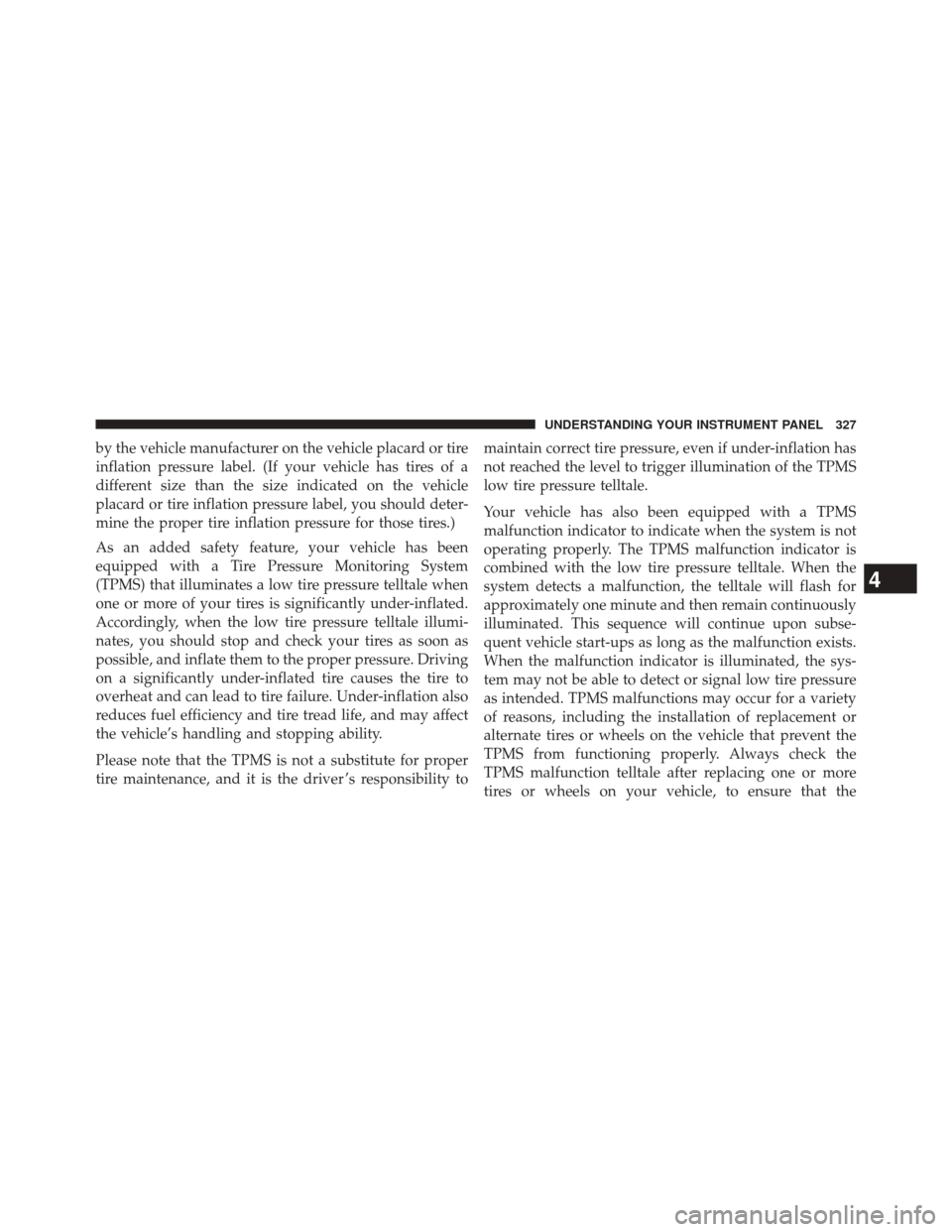
by the vehicle manufacturer on the vehicle placard or tire
inflation pressure label. (If your vehicle has tires of a
different size than the size indicated on the vehicle
placard or tire inflation pressure label, you should deter-
mine the proper tire inflation pressure for those tires.)
As an added safety feature, your vehicle has been
equipped with a Tire Pressure Monitoring System
(TPMS) that illuminates a low tire pressure telltale when
one or more of your tires is significantly under-inflated.
Accordingly, when the low tire pressure telltale illumi-
nates, you should stop and check your tires as soon as
possible, and inflate them to the proper pressure. Driving
on a significantly under-inflated tire causes the tire to
overheat and can lead to tire failure. Under-inflation also
reduces fuel efficiency and tire tread life, and may affect
the vehicle’s handling and stopping ability.
Please note that the TPMS is not a substitute for proper
tire maintenance, and it is the driver ’s responsibility tomaintain correct tire pressure, even if under-inflation has
not reached the level to trigger illumination of the TPMS
low tire pressure telltale.
Your vehicle has also been equipped with a TPMS
malfunction indicator to indicate when the system is not
operating properly. The TPMS malfunction indicator is
combined with the low tire pressure telltale. When the
system detects a malfunction, the telltale will flash for
approximately one minute and then remain continuously
illuminated. This sequence will continue upon subse-
quent vehicle start-ups as long as the malfunction exists.
When the malfunction indicator is illuminated, the sys-
tem may not be able to detect or signal low tire pressure
as intended. TPMS malfunctions may occur for a variety
of reasons, including the installation of replacement or
alternate tires or wheels on the vehicle that prevent the
TPMS from functioning properly. Always check the
TPMS malfunction telltale after replacing one or more
tires or wheels on your vehicle, to ensure that the
4
UNDERSTANDING YOUR INSTRUMENT PANEL 327
Page 332 of 698
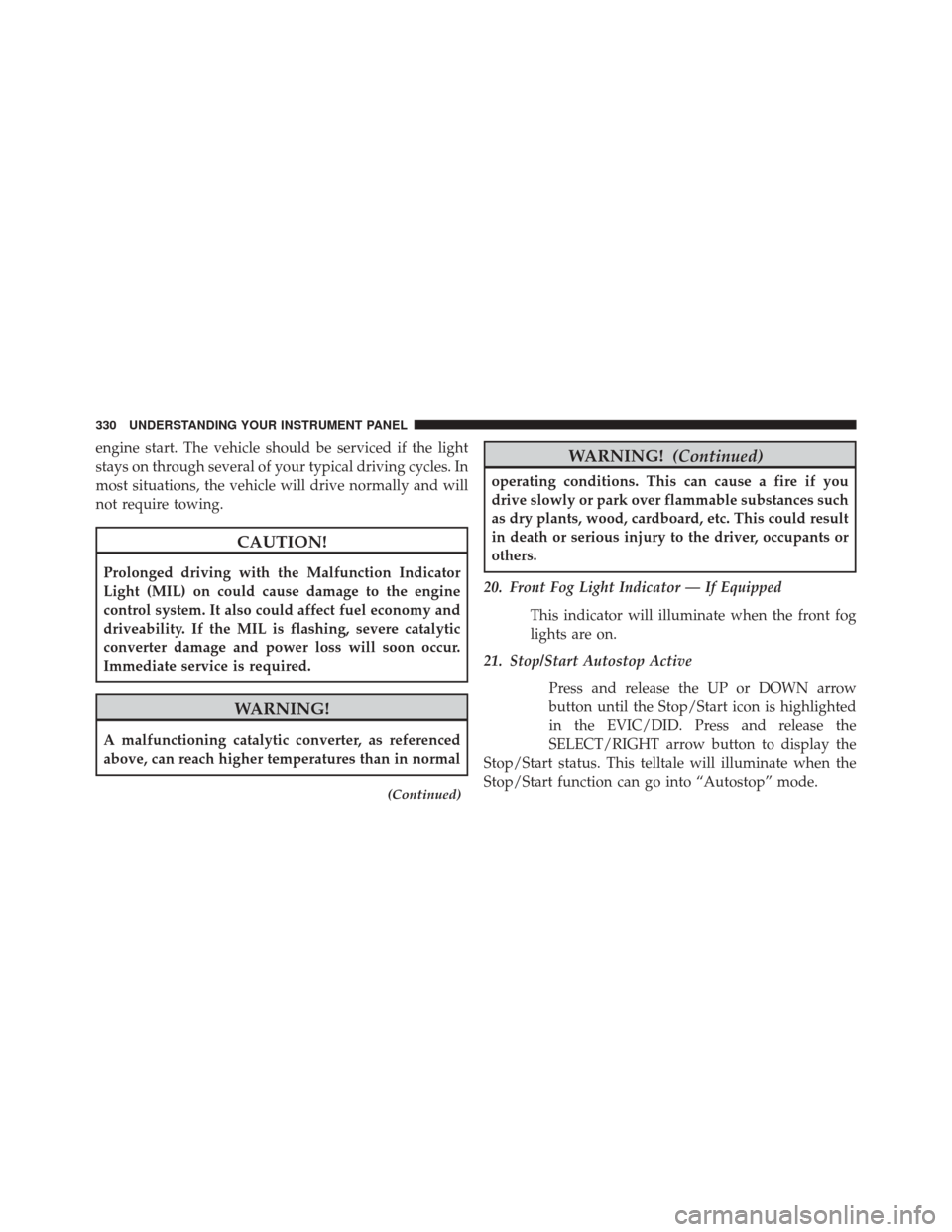
engine start. The vehicle should be serviced if the light
stays on through several of your typical driving cycles. In
most situations, the vehicle will drive normally and will
not require towing.
CAUTION!
Prolonged driving with the Malfunction Indicator
Light (MIL) on could cause damage to the engine
control system. It also could affect fuel economy and
driveability. If the MIL is flashing, severe catalytic
converter damage and power loss will soon occur.
Immediate service is required.
WARNING!
A malfunctioning catalytic converter, as referenced
above, can reach higher temperatures than in normal
(Continued)
WARNING!(Continued)
operating conditions. This can cause a fire if you
drive slowly or park over flammable substances such
as dry plants, wood, cardboard, etc. This could result
in death or serious injury to the driver, occupants or
others.
20. Front Fog Light Indicator — If Equipped This indicator will illuminate when the front fog
lights are on.
21. Stop/Start Autostop Active
Press and release the UP or DOWN arrow
button until the Stop/Start icon is highlighted
in the EVIC/DID. Press and release the
SELECT/RIGHT arrow button to display the
Stop/Start status. This telltale will illuminate when the
Stop/Start function can go into “Autostop” mode.
330 UNDERSTANDING YOUR INSTRUMENT PANEL
Page 335 of 698

ELECTRONIC VEHICLE INFORMATION CENTER
(EVIC)
The 3.5” Electronic Vehicle Information Center (EVIC)
display is located in the instrument cluster.The EVIC Main Menu items consists of the following:
•
Speedometer
• Vehicle Info
• Fuel Economy Info
• Trip (Trip A/Trip B)
• Stop/Start — If Equipped
• Audio Info
• Messages
• Screen Setup
• Settings
Electronic Vehicle Information Center (EVIC) Display
4
UNDERSTANDING YOUR INSTRUMENT PANEL 333
Page 336 of 698

The system allows the driver to select information by
pressing the following buttons mounted on the steering
wheel:•
UP Arrow Button
Press and release the UP arrow button to scroll
upward through the Main Menu items ( Speed-
ometer, Vehicle Info, Fuel Economy, Trip A,
Trip B, Stop/Start, Audio, Messages, Screen Set
Up, Settings).
• DOWN Arrow Button
Press and release the DOWN arrow button to
scroll downward through the Main Menu
items (Speedometer, Vehicle Info, Fuel
Economy, Trip A, Trip B, Stop/Start, Audio,
Messages, Screen Set Up, Settings).
• RIGHT Arrow Button
Press and release the RIGHT arrow button to
access the information screens or submenu
screens of a main menu item.
EVIC Controls
334 UNDERSTANDING YOUR INSTRUMENT PANEL
Page 342 of 698
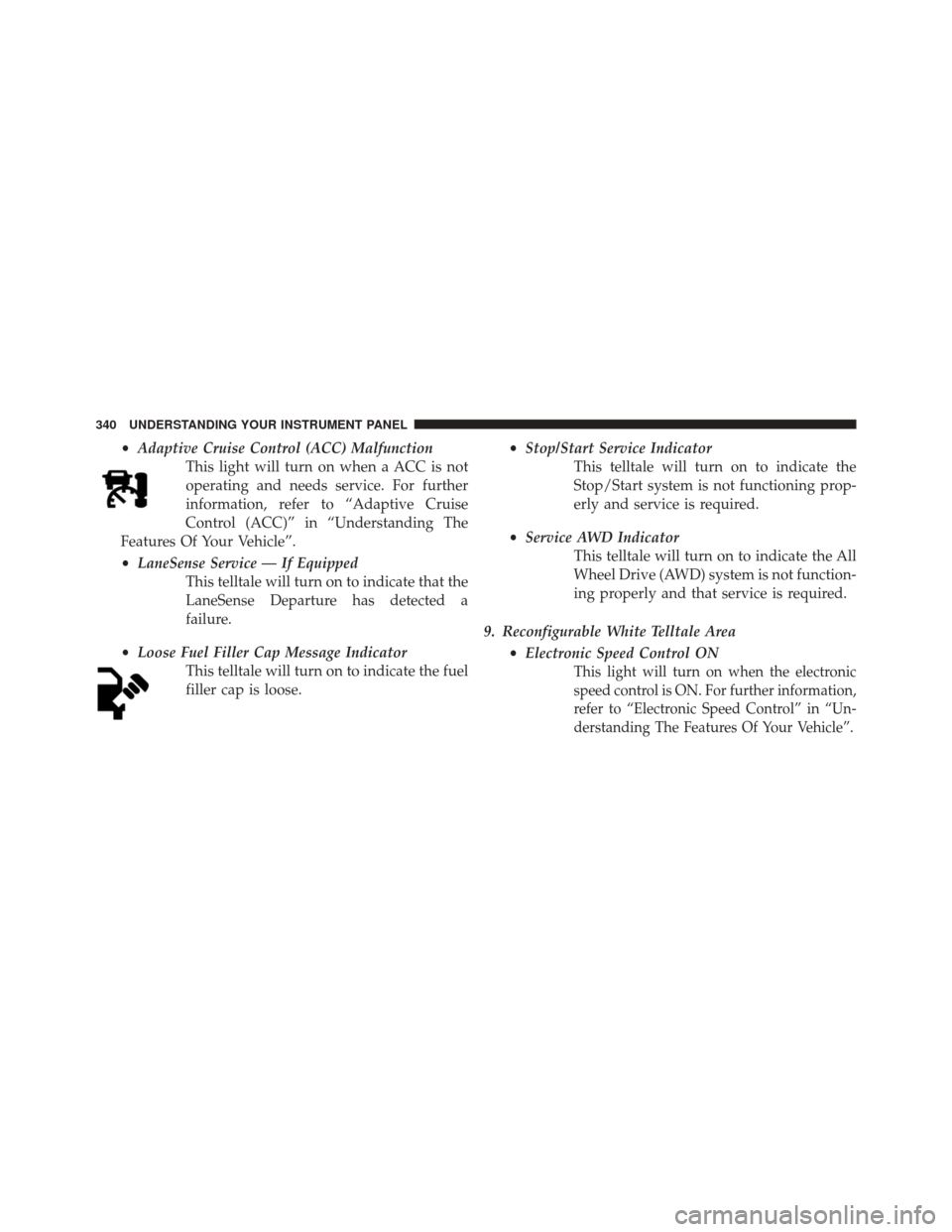
•Adaptive Cruise Control (ACC) Malfunction
This light will turn on when a ACC is not
operating and needs service. For further
information, refer to “Adaptive Cruise
Control (ACC)” in “Understanding The
Features Of Your Vehicle”.
• LaneSense Service — If Equipped
This telltale will turn on to indicate that the
LaneSense Departure has detected a
failure.
• Loose Fuel Filler Cap Message Indicator
This telltale will turn on to indicate the fuel
filler cap is loose. •
Stop/Start Service Indicator
This telltale will turn on to indicate the
Stop/Start system is not functioning prop-
erly and service is required.
• Service AWD Indicator
This telltale will turn on to indicate the All
Wheel Drive (AWD) system is not function-
ing properly and that service is required.
9. Reconfigurable White Telltale Area •Electronic Speed Control ON
This light will turn on when the electronic
speed control is ON. For further information,
refer to “Electronic Speed Control” in “Un-
derstanding The Features Of Your Vehicle”.
340 UNDERSTANDING YOUR INSTRUMENT PANEL
Page 343 of 698

•Electronic Speed Control SET
This light will turn on when the electronic
speed control is SET. For further information,
refer to “Electronic Speed Control” in “Un-
derstanding The Features Of Your Vehicle”.
•Adaptive Cruise Control (ACC) Set
This light will turn on when the vehicle
equipped with Adaptive Cruise Control
(ACC) has reached the speed desired and
the set button has been selected. For further informa-
tion, refer to “Electronic Speed Control” in “Under-
standing The Features Of Your Vehicle”.
• Adaptive Cruise Control (ACC) Ready
This light will turn on when the vehicle
equipped with Adaptive Cruise Control
(ACC) has been turned on and in the READY
state. For further information, refer to “Electronic
Speed Control” in “Understanding The Features Of
Your Vehicle”. 10. Reconfigurable Red Telltale Display
•Oil Temperature Warning Light
This telltale indicates engine oil tempera-
ture is high. If the light turns on while
driving, stop the vehicle and shut off the
engine as soon as possible.
• Power Steering System Over Temperature — If
Equipped If the “SERVICE POWER STEERING” mes-
sage and a steering wheel icon are dis-
played on the EVIC/DID screen, it indi-
cates that the vehicle needs to be taken to
the dealer for service. It is likely the vehicle has lost
power steering assistance. Refer to “Power Steering”
in “Starting and Operating” for further information.
4
UNDERSTANDING YOUR INSTRUMENT PANEL 341
Page 344 of 698
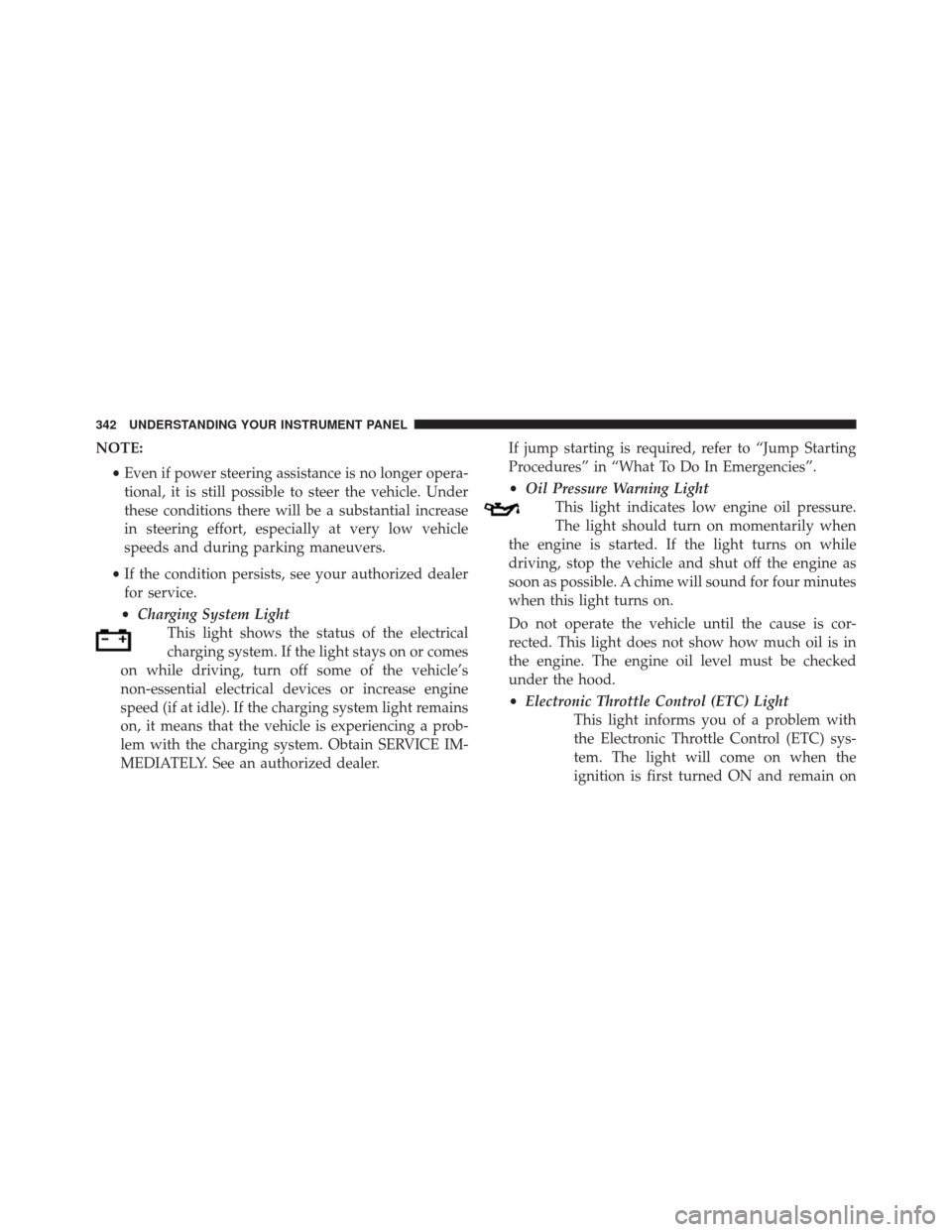
NOTE:•Even if power steering assistance is no longer opera-
tional, it is still possible to steer the vehicle. Under
these conditions there will be a substantial increase
in steering effort, especially at very low vehicle
speeds and during parking maneuvers.
• If the condition persists, see your authorized dealer
for service.
• Charging System Light
This light shows the status of the electrical
charging system. If the light stays on or comes
on while driving, turn off some of the vehicle’s
non-essential electrical devices or increase engine
speed (if at idle). If the charging system light remains
on, it means that the vehicle is experiencing a prob-
lem with the charging system. Obtain SERVICE IM-
MEDIATELY. See an authorized dealer. If jump starting is required, refer to “Jump Starting
Procedures” in “What To Do In Emergencies”.
•
Oil Pressure Warning Light
This light indicates low engine oil pressure.
The light should turn on momentarily when
the engine is started. If the light turns on while
driving, stop the vehicle and shut off the engine as
soon as possible. A chime will sound for four minutes
when this light turns on.
Do not operate the vehicle until the cause is cor-
rected. This light does not show how much oil is in
the engine. The engine oil level must be checked
under the hood.
• Electronic Throttle Control (ETC) Light
This light informs you of a problem with
the Electronic Throttle Control (ETC) sys-
tem. The light will come on when the
ignition is first turned ON and remain on
342 UNDERSTANDING YOUR INSTRUMENT PANEL
Page 345 of 698
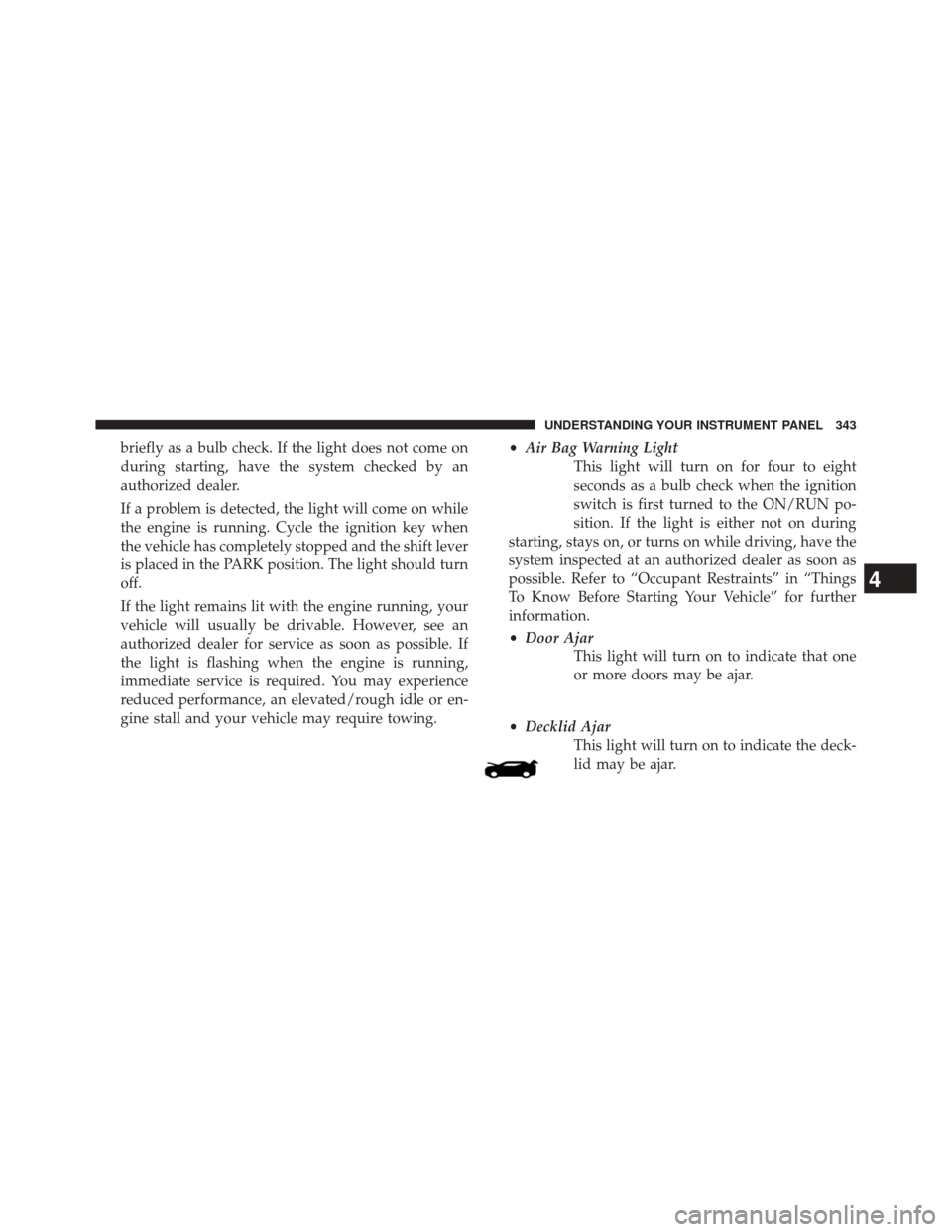
briefly as a bulb check. If the light does not come on
during starting, have the system checked by an
authorized dealer.
If a problem is detected, the light will come on while
the engine is running. Cycle the ignition key when
the vehicle has completely stopped and the shift lever
is placed in the PARK position. The light should turn
off.
If the light remains lit with the engine running, your
vehicle will usually be drivable. However, see an
authorized dealer for service as soon as possible. If
the light is flashing when the engine is running,
immediate service is required. You may experience
reduced performance, an elevated/rough idle or en-
gine stall and your vehicle may require towing.•
Air Bag Warning Light
This light will turn on for four to eight
seconds as a bulb check when the ignition
switch is first turned to the ON/RUN po-
sition. If the light is either not on during
starting, stays on, or turns on while driving, have the
system inspected at an authorized dealer as soon as
possible. Refer to “Occupant Restraints” in “Things
To Know Before Starting Your Vehicle” for further
information.
• Door Ajar
This light will turn on to indicate that one
or more doors may be ajar.
• Decklid Ajar
This light will turn on to indicate the deck-
lid may be ajar.
4
UNDERSTANDING YOUR INSTRUMENT PANEL 343
Page 348 of 698

release the OK button. To reset the oil change indicator
system (after performing the scheduled maintenance)
refer to the following procedure.
1. Without pushing the brake pedal, push the ENGINESTART/STOP button and cycle the ignition to the
ON/RUN position (do not start the engine.)
2. Fully depress the accelerator pedal, slowly, three times within 10 seconds.
3. Without pushing the brake pedal, push the ENGINE START/STOP button once to return the ignition to the
OFF/LOCK position.
NOTE: If the indicator message illuminates when you
start the vehicle, the oil change indicator system did not
reset. If necessary, repeat this procedure.Instrument Cluster Messages For (EVIC) And
(DID)
• Front Seatbelts Unbuckled
• Driver Seatbelt Unbuckled
• Passenger Seatbelt Unbuckled
• Service Airbag System
• Traction Control Off
• Washer Fluid Low
• Oil Pressure Low
• Oil Change Due
• Fuel Low
• Service Antilock Brake System
• Service Electronic Throttle Control
346 UNDERSTANDING YOUR INSTRUMENT PANEL